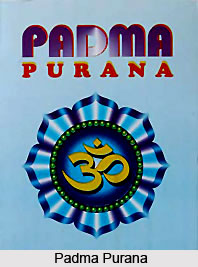 Padma Purana is one of the major Puranas among the eighteen Mahapuranas and an ancient Hindu religious text. There are five parts in this Purana. The first part of this Purana deals with sage Pulastya`s (one of the seven Prajapatis or mind born son of Lord Brahma) explanation about religion and the essence of religion to Bhishma. `Prithvi` or the earth is described vividly in the second part of the Padma Purana. The third part, on the other hand, describes the `cosmos` and India (Bharat Mata). The life and deeds of Lord Rama are described in the fourth part of the Purana. The fifth part is written in the style of a conversation between Lord Shiva and his spouse, Parvati, and deals with the indispensable knowledge about religion.
Padma Purana is one of the major Puranas among the eighteen Mahapuranas and an ancient Hindu religious text. There are five parts in this Purana. The first part of this Purana deals with sage Pulastya`s (one of the seven Prajapatis or mind born son of Lord Brahma) explanation about religion and the essence of religion to Bhishma. `Prithvi` or the earth is described vividly in the second part of the Padma Purana. The third part, on the other hand, describes the `cosmos` and India (Bharat Mata). The life and deeds of Lord Rama are described in the fourth part of the Purana. The fifth part is written in the style of a conversation between Lord Shiva and his spouse, Parvati, and deals with the indispensable knowledge about religion.
Origin of Padma Purana
It is quite impossible to say anything definite as to the date of the Padma-Purana, It is rather loose compilations parts of which belongs to totally different periods and are probably many centuries apart. The common characteristic of the five or six books is merely their rigidly sectarian character, for all of them inculcate the cult of Lord Vishnu. Moreover, all these books contain references to fairly modern aspects of the Vishnu cult, such as the adoration of Radha as a goddess, the sanctity of the Salagrama stone, of the Tulsi plant, and the like. The latest portions are certainly later than the Bhagavata Purana, which belongs to the latest works of Purana literature. Nevertheless there is sure to be an ancient nucleus at least in the Sristi, Bhumi, Swarga and Patala Khandas.
Khandas in Padma Purana
The following five Khandas are contauned in the Padma Puranas- Book I, Srishti Khanda, i.e. section of the Creation; Book II, Bhumi Khanda i.e. section of the earth; Book III, Swarga Khanda, i.e. section of the heavens; Book IV, Patala Khanda, i.e. section of the nether world and, Book V, Uttara Khanda, i.e. last section. A kind of appendix to the Uttara Khanda is formed by the Kriyayogasara, i.e. the essence of Yoga.
The Srishti Khanda or Book of the Universe is written in a style of conversation between Bhishma and the sage Pulastya. It also encloses a detailed description of Pushkara, a renowned place of pilgrimage. Bhumi Khanda or the Book of Earth, on the other hand, gives a vivid description of Prithvi (earth) and tales of kings like Prithu and Yayati and several other sages. According to some scholars, the stories of Kings like Prithu, Yayati and sages in this Purana describes elements of geography and history of the Period. Swarga Khanda or the Book of Heaven illustrates details of the progression of creation of the cosmos. The implication and descriptions of holy places are also described in this part. Moreover, it gives deals with the geographical expansion and features of Jambudvipa, including its mountains and rivers. It also narrates about the ancient people of India. The Patala Khanda or the Book of the Underworld accords the life story of Rama, an avatar of Vishnu, is narrated by Ugrasrava Sauti to an assembly of sages. Few other sections of the book deal with the life and deeds of Lord Krishna.
The metaphysical aspect of religion is presented in a style of conversation between Shiva and Parvati in the Uttara Khanda of the Padma Purana. This part also contains the sections with Vishnu sahasranama (1000 names of Vishnu) and Rama sahasranama (1000 names of Rama). As the name suggests, it is also related with the Uttarkhand region of the Indian Himalayas. Here Lord Shiva and his consort Parvati are believed to preside over as the source of Ganga River and Yamuna River, residences of Vishnu at Badrinath and Shiva at Kedarnath, and the river Ganga`s access into the plains of India at Haridwar.
Thus discussed is the Padma Purana, one of the eighteen Mahapuranas.












